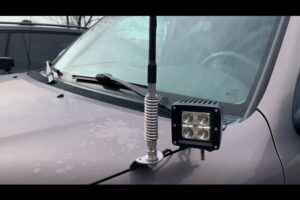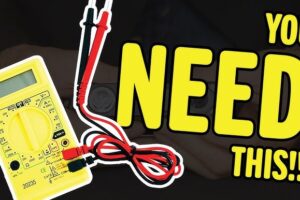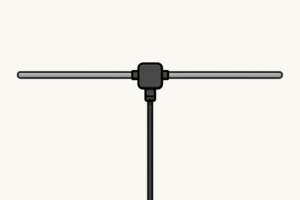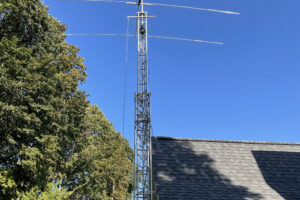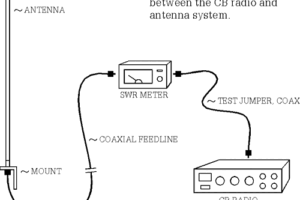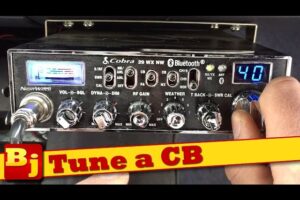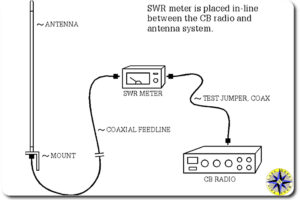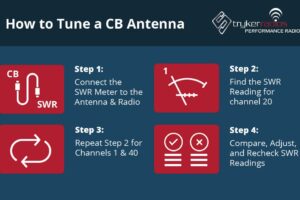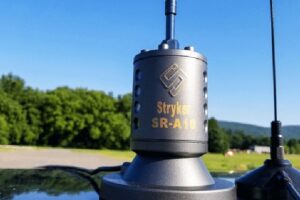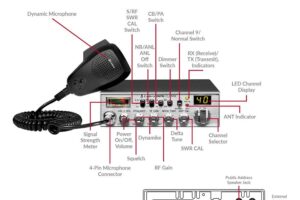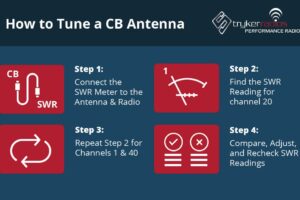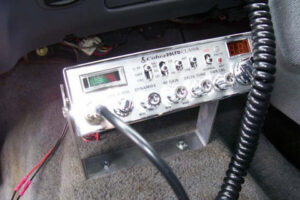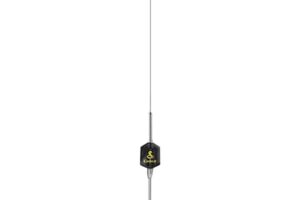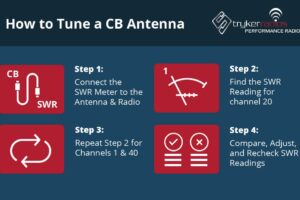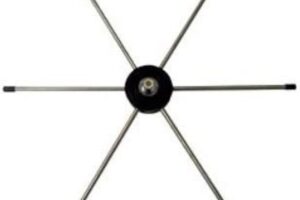How to Make a CB Radio Antenna: Step-by-Step Guide
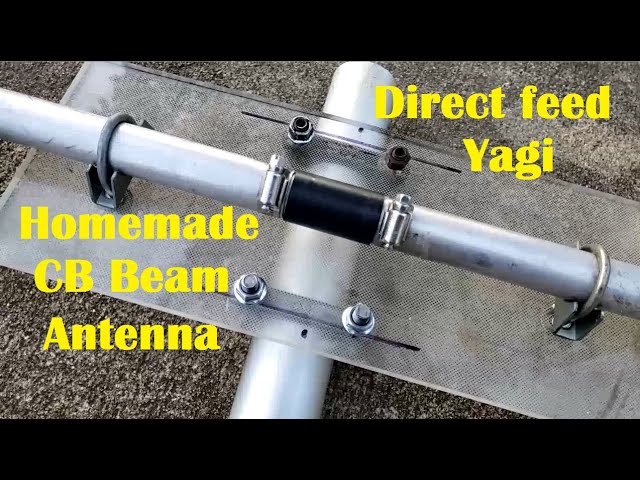
Building a CB radio antenna isn’t as hard as it seems. With the right materials and instructions, anyone can do it.
CB radios are essential for communication in many scenarios. Whether you’re a truck driver, a hobbyist, or preparing for emergencies, a good antenna is crucial. Making your own CB radio antenna can save money and improve performance. It allows you to customize the antenna to your specific needs.
This guide will walk you through the process, step by step. Soon, you’ll have a reliable antenna ready for use. Let’s get started on creating an effective CB radio antenna.

Credit: www.wikihow.com
Materials Needed
Creating your own CB radio antenna can be a rewarding project. To get started, you need to gather some essential materials. This section will guide you through the tools and supplies necessary for building an effective antenna.
Essential Tools
Having the right tools is crucial for any DIY project. Here are the tools you will need:
- Wire cutters: For cutting the antenna wire to the right length.
- Wire strippers: To remove insulation from the wire ends.
- Soldering iron: Useful for making secure connections.
- Multimeter: To check the electrical properties of your antenna.
- Measuring tape: Ensures your wire lengths are accurate.
- Screwdriver: For tightening connections and mounting the antenna.
Recommended Supplies
Besides tools, you will need several supplies to build your CB radio antenna. Here are the recommended supplies:
- Antenna wire: Choose a sturdy wire, usually 14-gauge copper.
- Coaxial cable: RG-58 or RG-8X are good options for CB radios.
- Coax connectors: PL-259 connectors work well for CB antennas.
- Solder: Use high-quality solder for strong electrical connections.
- Insulators: Essential for preventing signal loss and maintaining safety.
- Mounting hardware: Brackets, clamps, or poles to secure your antenna.
Preparation
Preparing to make a CB radio antenna is crucial. Proper preparation ensures optimal performance and safety. This section will guide you through selecting the right location and important safety precautions.
Selecting The Right Location
Choosing the correct location for your CB radio antenna is vital. The antenna should be in a clear, unobstructed area. This allows for better signal reception and transmission. Avoid placing it near large metal objects. These can interfere with the signal. Also, ensure the location is accessible for maintenance.
Safety Precautions
Safety is a top priority when making a CB radio antenna. First, always wear safety gear. Gloves and goggles are essential. Protect yourself from sharp objects and electrical hazards. Second, ensure the area is free of electrical lines. This reduces the risk of electrocution. Third, use insulated tools. These tools minimize the risk of electrical shocks. Lastly, keep a first aid kit nearby. Be prepared for any minor injuries.
Building The Antenna
Building the Antenna for your CB radio can be an exciting and rewarding DIY project. It’s easier than you might think, and you can customize it to fit your needs. Let’s break down the process into two main parts: constructing the base and creating the radiating element.
Constructing The Base
The base of your antenna is crucial. It needs to be stable and sturdy to support the radiating element. Start by selecting a solid material like PVC pipe or aluminum tubing. These materials are durable and easy to work with.
Cut your chosen material to the desired length, typically around 5 feet for a standard CB radio antenna. Use a hacksaw or pipe cutter for precision. Safety tip: wear gloves and goggles to protect yourself.
Next, drill a hole at the bottom of the pipe for the mounting hardware. This allows you to securely attach the base to a support structure. Whether you mount it to a vehicle or a stationary location, ensure the base is firmly anchored.
Creating The Radiating Element
The radiating element is the part of the antenna that sends and receives signals. Copper wire is a great choice due to its excellent conductivity. Measure and cut a length of wire, about 102 inches, which is a common size for CB antennas.
Strip the insulation off both ends of the wire. This will allow for better connection and signal transmission. Attach one end to the top of the base using a strong adhesive or a clamp for a secure fit.
Form the wire into a vertical position. This orientation helps in capturing the best signals. Use zip ties or clamps to keep it straight and stable. You can adjust the height and angle to fine-tune your reception.
Are you ready to build your own CB radio antenna? Imagine the satisfaction of tuning in and having crystal-clear communication on your custom-built setup. Dive into the project, and let your creativity flow!
Tuning The Antenna
Adjusting the CB radio antenna improves signal strength and clarity. Position the antenna vertically for best performance. Test and tweak the length to find the optimal setting.
Tuning the Antenna
Creating your own CB radio antenna can be a rewarding experience, but tuning it properly is essential for optimal performance. This step ensures your antenna is set to the right frequency for clear communication. Let’s dive into how you can tune your antenna effectively.
Adjusting For Optimal Performance
Start by positioning your antenna in a clear area, away from any obstructions. This helps in getting accurate readings.
Next, adjust the length of the antenna. A longer antenna often improves reception, but it must be tuned to the right frequency.
You can shorten or lengthen the antenna by loosening the set screw and moving the whip in or out. Tighten the set screw once you’ve adjusted the length.
Using A Swr Meter
An SWR (Standing Wave Ratio) meter is a crucial tool for tuning your antenna. It measures the efficiency of your antenna system.
Connect the SWR meter between the antenna and the CB radio. Follow the instructions provided with the meter for a proper setup.
Transmit a signal and check the reading on the SWR meter. Ideally, you want a reading of 1.5 or lower. If the reading is higher, adjust the antenna length again and recheck.
Repeat the adjustment and measurement process until you get the desired reading. This ensures your antenna is tuned for optimal performance.
Have you ever struggled with tuning your antenna? Share your experience in the comments below!
Installation
Installing your CB radio antenna correctly is crucial for optimal performance. A properly installed antenna ensures clear communication and maximum range. This section will guide you through the steps to mount your antenna and connect it to your CB radio.
Mounting The Antenna
The first step is finding the right spot to mount your antenna. You want to place it high and in the center of your vehicle to get the best signal. The roof is often the ideal spot.
Start by cleaning the area where you plan to mount the antenna. Dirt and debris can interfere with the connection. Use a strong adhesive or mount to secure it tightly.
If you’re using a magnet mount, ensure it is firmly attached to prevent it from flying off while driving. For a more permanent solution, drill a hole and use bolts to secure the mount.
Connecting To The Cb Radio
Once your antenna is securely mounted, it’s time to connect it to your CB radio. First, run the coaxial cable from the antenna to the CB radio. Make sure the cable is long enough to reach but avoid having too much slack.
Connect the coaxial cable to the antenna and then to the CB radio. The connections should be tight to prevent any signal loss. Use a wrench to tighten the connections if necessary.
After connecting the cable, turn on your CB radio to test the setup. Check for any signal issues or interference. Adjust the antenna’s position if needed to improve the signal.
Installation can seem daunting, but with patience and careful attention to detail, you can achieve a professional setup. What’s your biggest challenge when installing a CB antenna? Share your thoughts in the comments!
Testing And Troubleshooting
After building your CB radio antenna, testing and troubleshooting is important. This ensures it works properly. You might face some common issues. Let’s learn how to test and fix them. Follow these steps to ensure your antenna is ready to use.
Checking Signal Strength
First, check the signal strength of your CB radio. Turn on the radio and set it to a clear channel. Listen for any noise or interference. A strong signal means your antenna is working well. If the signal is weak, there might be a problem.
Use a signal meter to measure the strength. Connect the meter between the radio and the antenna. Check the readings. They should be within the normal range. If not, your antenna needs adjustment.
Common Issues And Fixes
Several common issues can affect your antenna’s performance. Let’s look at some of them.
Poor Grounding: Ensure your antenna is properly grounded. A bad ground can cause weak signals. Check the connections. Make sure they are secure and clean. A good ground connection improves signal strength.
Incorrect Length: The length of your antenna affects its performance. Measure the antenna length. It should match the recommended length for CB radios. If it’s too long or short, adjust it accordingly.
Damaged Coaxial Cable: Check the coaxial cable for any damage. A damaged cable can cause signal loss. Replace any damaged sections. Ensure the connectors are tight and secure.
Interference: Electronic devices can cause interference. Move your antenna away from other electronic devices. This reduces noise and improves signal quality.
By following these steps, you can test and troubleshoot your CB radio antenna. Ensure it is working at its best.
Maintenance Tips
Maintaining your CB radio antenna ensures its longevity and performance. Proper care helps you avoid signal issues and costly repairs. Here are some essential maintenance tips.
Routine Checks
Regular inspections keep your antenna in good condition. Examine the antenna and connections for wear. Look for cracks, rust, and loose fittings. Tighten any loose screws or bolts.
Clean the antenna with a soft cloth. Remove dirt and debris that may impact performance. Use a mild detergent if needed. Avoid harsh chemicals which can damage the antenna.
Long-term Care
Protect your antenna from extreme weather. Cover it during storms or when not in use. Store it in a dry place to prevent rust.
Check the cable connections periodically. Replace worn-out cables to maintain signal strength. Keep the antenna height consistent for optimal reception.
Inspect the mounting hardware. Ensure it remains secure and free from corrosion. Regular maintenance extends the life of your CB radio antenna.

Credit: www.youtube.com
Frequently Asked Questions
Can You Make A Homemade Cb Antenna?
Yes, you can make a homemade CB antenna. Use simple materials like wire and connectors. Follow online guides for instructions.
What Makes A Good Cb Antenna?
A good CB antenna has a high gain, proper tuning, and a strong, durable build. Ensure it is properly grounded.
How Do I Increase The Signal Strength On My Cb Radio?
To increase CB radio signal strength, use a high-quality antenna and ensure proper installation. Adjust the SWR (Standing Wave Ratio) for optimal performance. Regularly check connections and cables for any damage.
What Can I Use To Make A Homemade Antenna?
You can use coat hangers, aluminum foil, or copper wire to make a homemade antenna. Attach them to a sturdy base.
Conclusion
Building a CB radio antenna can be a rewarding project. It requires basic materials and tools. Follow simple steps to ensure optimal performance. Correct installation boosts signal clarity and range. Regular checks help maintain efficiency. Enjoy the satisfaction of creating your own antenna.
It’s a practical skill to learn. Engage with fellow radio enthusiasts. Share experiences and tips. This DIY approach fosters creativity and learning. With practice, you’ll master antenna construction. Happy building and enjoy your radio adventures. Your communication journey starts here.

